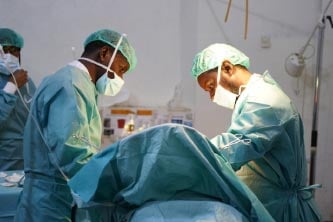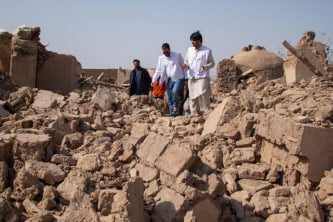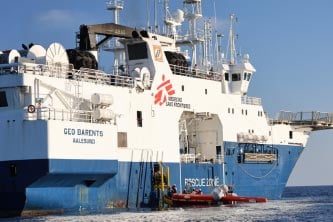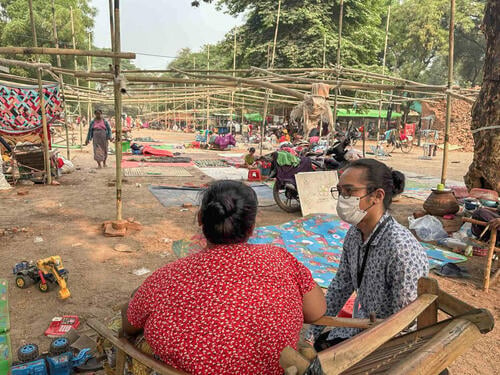On 28 March, a 7.7 magnitude earthquake struck central Myanmar. From the epicentre in the city of Sagaing, the tremors were felt across Thailand, Bangladesh, China and Laos. Our teams already in the country immediately mobilised to travel to the affected areas in Sagaing, Mandalay, Naypyitaw and Southern Shan states to assess initial needs, while our emergency teams prepared to arrive in Myanmar as earlier as possible.
Jessa Pontevedra, an emergency coordinator based in southeast Asia, was one of them. She shares her experiences from the first week of our emergency response in Myanmar.
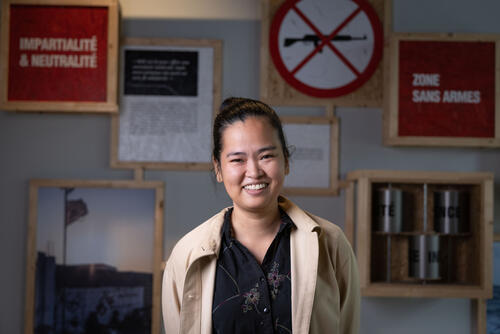
We landed in Yangon in the middle of the night on 1 April and headed directly to the Médecins Sans Frontières (MSF) office for briefings. After a few hours of rest, we set out the next morning on the 6.5-hour long drive to Naypyitaw, mainly along the highway to join the team who had already gone there on 30 March.
But about 100 kilometres from the city we started seeing the impact of the earthquake – cracks marred the road, a stark reminder of the disaster’s reach. We entered this well-designed city, Myanmar’s capital, and checked into a hotel, where some displaced families who could afford it had taken refuge.
In the evening, we met the rest of the emergency team to set the objectives for the coming days. As a medical coordinator, my role is to assess the health situation: evaluating both the condition of medical facilities and the urgent needs of affected people.
A maternity ward in a jewellery museum
Before the earthquake, Naypyidaw boasted major medical institutions: a 1,000-bed hospital, a 500-bed paediatric hospital, 500-bed orthopaedic hospital, 500-bed maternity, and more. Yet, all of these large, specialised hospitals couldn’t operate to their full capacity due to structural damage to the facilities.
One of the more striking examples of adaptation was the repurposing of a 500 beds-obstetric-children’s hospital. The patients, staff and some of the equipment relocated to an unoccupied private jewellery museum that was untouched by the earthquake. The owner, eager to help, welcomed the maternity in his building and compound. The museum, originally intended to be a high-end tourist attraction, had become an emergency healthcare space. Inside the grand rooms, there were rows and rows of beds set up for pregnant women about to give birth.
A metal detector at the entrance now served as the triage point, with desks further inside used for antenatal and postnatal consultations. Other rooms were transformed into emergency wards, and an operating theatre was already performing caesarean sections. Staff, who were themselves displaced, had set up tents to sleep in the compound, as well as the families of patients. A brick building in the back of the compound which looked like a train station, was used as the administration offices and kitchen for the staff.

I saw a lot of solidarity and dedication
There, I met the superintendent of the hospital, who took the time to speak with us despite the challenging situation. Amid the hectic environment, she was still smiling. Staff and patient’s families were sharing the place, sharing meals, offering donations to the ones in need, supporting each other… acting as a big community. Everyone was coping as best they could… collectively.
A paediatric hospital, originally another 500-bed facility, had been relocated across the city and was now operating as a 32-bed township hospital – without any operating theatre. Looking at the community's needs – pregnant women give birth, and kids get sick even amidst a natural disaster –, a 500-bed hospital becoming a 32-bed hospital, the math was not adding up.
The encounter with the superintendent at this facility, deeply touched me. The healthcare professionals were so dedicated, trying their best. The community spirit everywhere and coming together really resonated with me as I am southeast Asian, and this is a big part of our culture. Coming together in times of needs… They were also appreciative that MSF is with them in this emergency.
Many people experiencing homelessness in an urban space
Five days later, I left Naypyidaw, taking the old highway instead of the express road. As we approached Mandalay city, we saw makeshift shelters of plastic sheeting on one side of the road, housing perhaps 1,000 people. On the other side, buildings lay in ruins. The following days, as we moved around the city to assess the hospitals, we saw similar damages – collapsed homes and communities in disarray. Many affected people were quite vulnerable, without access to water and sanitation, lacking the basic requirement to preserve their dignity.

In Mandalay, families who chose to stay close to their damaged or collapsed houses were staying at the gates or front yard, or along the street - some even re-entering their damaged houses, risking further injury just to access basic facilities like bathrooms. The hospitals were partially functional and able to attend to the injured – although oftentimes outside barely shielded from the elements by simple tarps.
Throughout these assessments, our teams have already been providing basic health consultations, psychological first aid to the affected communities and distributed essential items such as hygiene kits in cooperation with local civil society organisations. The logistics teams have been working tirelessly to restore water and sanitation facilities, setting up latrines in monasteries where many displaced families sought refuge.
More challenges may come
With the rainy season approaching, the challenges are mounting. The situation might become increasingly precarious. If thousands of people are experiencing homeless in urban areas, and with the risk of disease outbreaks, responding to their needs will be incredibly challenging.
What I witnessed in Naypyidaw touched me to my core as a public health professional, but what I saw in Mandalay touched to my core as humanitarian.
For now, the communities are finding ways to support one another. I remember one couple staying at the same hotel in Naypyidaw, that I met when I was out for my usual run. They were also doing their morning exercise. It was the man’s birthday that day. But given the situation, the celebration would not be a party. “We have lost our home too,” he said, “But we are bit more blessed, so we want to give back.” And they did so by doing food, water and essential item distributions in one of the most affected neighbourhoods of Naypyidaw.
I also keep in mind this doctor I met. He was from a less affected town who had rallied a group of healthcare colleagues to set up a free clinic. They quickly began receiving donations from people abroad - food, essential items, and more. This spirit of community in Myanmar is powerful, but I can’t help but wonder: how long can it last?
Our emergency teams continue to work almost around the clock, further assessing and anticipating the needs, supporting the relief efforts wherever possible along with the communities that are so engaged. The recovery from this massive earthquake will be long for the affected people, no matter where they live, they need to have access to life-saving humanitarian assistance.
